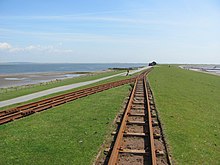Our website is made possible by displaying online advertisements to our visitors.
Please consider supporting us by disabling your ad blocker.
Zig zag (railway)







A railway zig zag or switchback is a railway operation in which a train is required to switch its direction of travel in order to continue its journey. While this may be required purely from an operations standpoint, it is also ideal for climbing steep gradients with minimal need for tunnels and heavy earthworks.[1] For a short distance (corresponding to the middle leg of the letter "Z"), the direction of travel is reversed, before the original direction is resumed.[2] Some switchbacks do not come in pairs, and the train may then need to travel backwards for a considerable distance.
A location on railways constructed by using a zig-zag alignment at which trains must reverse direction to continue is a reversing station.[3]
One of the best examples is the Darjeeling Himalayan Railway, a UNESCO World Heritage Site railway in India, which has six full zig zags and three spirals.[4]
- ^ Raymond, William G. (1912). "Railway Engineering" (Google books). In Beach, Frederick Converse (ed.). The Americana: A Universal Reference Library, Comprising the Arts and Sciences, Literature, History, Biography, Geography, Commerce, Etc., of the World. Vol. 17. New York: Scientific American Compiling Department. Retrieved 3 January 2010.
High mountain levels … may be tunneled … but … may be reached by one of several methods adopted to secure practical grades: (1) Zig-zag development … (2) Switchback development … (3) Spirals or loops …
- ^ Raymond 1912. "Switch-back development … necessitating the use of switches at these ends and the backing of the train up alternate stretches."
- ^ Jackson, Alan A. (2006). The Railway Dictionary (4th ed.). Stroud: Sutton Publishing. p. 285. ISBN 0-7509-4218-5.
- ^ "Mountain Railways of India". UNESCO World Heritage Centre. Retrieved 30 April 2006.
Previous Page Next Page


